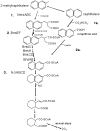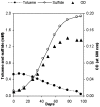Genome sequence of the deltaproteobacterial strain NaphS2 and analysis of differential gene expression during anaerobic growth on naphthalene
- PMID: 21124915
- PMCID: PMC2988823
- DOI: 10.1371/journal.pone.0014072
Genome sequence of the deltaproteobacterial strain NaphS2 and analysis of differential gene expression during anaerobic growth on naphthalene
Abstract
Background: Anaerobic polycyclic hydrocarbon (PAH) degradation coupled to sulfate reduction may be an important mechanism for in situ remediation of contaminated sediments. Steps involved in the anaerobic degradation of 2-methylnaphthalene have been described in the sulfate reducing strains NaphS3, NaphS6 and N47. Evidence from N47 suggests that naphthalene degradation involves 2-methylnaphthalene as an intermediate, whereas evidence in NaphS2, NaphS3 and NaphS6 suggests a mechanism for naphthalene degradation that does not involve 2-methylnaphthalene. To further characterize pathways involved in naphthalene degradation in NaphS2, the draft genome was sequenced, and gene and protein expression examined.
Results: Draft genome sequencing, gene expression analysis, and proteomic analysis revealed that NaphS2 degrades naphthoyl-CoA in a manner analogous to benzoyl-CoA degradation. Genes including the previously characterized NmsA, thought to encode an enzyme necessary for 2-methylnaphthalene metabolism, were not upregulated during growth of NaphS2 on naphthalene, nor were the corresponding protein products. NaphS2 may possess a non-classical dearomatizing enzyme for benzoate degradation, similar to one previously characterized in Geobacter metallireducens. Identification of genes involved in toluene degradation in NaphS2 led us to determine that NaphS2 degrades toluene, a previously unreported capacity. The genome sequence also suggests that NaphS2 may degrade other monoaromatic compounds.
Conclusion: This study demonstrates that steps leading to the degradation of 2-naphthoyl-CoA are conserved between NaphS2 and N47, however while NaphS2 possesses the capacity to degrade 2-methylnaphthalene, naphthalene degradation likely does not proceed via 2-methylnaphthalene. Instead, carboxylation or another form of activation may serve as the first step in naphthalene degradation. Degradation of toluene and 2-methylnaphthalene, and the presence of at least one bss-like and bbs-like gene cluster in this organism, suggests that NaphS2 degrades both compounds via parallel mechanisms. Elucidation of the key genes necessary for anaerobic naphthalene degradation may provide the ability to track naphthalene degradation through in situ transcript monitoring.
Conflict of interest statement
Figures





References
-
- Rothermich MM, Hayes LA, Lovley DR. Anaerobic, sulfate-dependent degradation of polycyclic aromatic hydrocarbons in petroleum-contaminated harbor sediment. Environ Sci Technol. 2002;36:4811–4817. - PubMed
-
- Bamforth SM, Singleton I. Bioremediation of polycyclic aromatic hydrocarbons: current knowledge and future directions. J Chem Technol Biotechnol. 2005;80:723–736.
-
- Coates JD, Anderson RT, Woodward JC, Phillips EJP, Lovley DR. Anaerobic hydrocarbon degradation in petroleum-contaminated harbor sediments under sulfate-reducing and artificially imposed iron-reducing conditions. Environ Sci Technol. 1996;30:2784–2789.
Publication types
MeSH terms
Substances
LinkOut - more resources
Full Text Sources
Molecular Biology Databases

